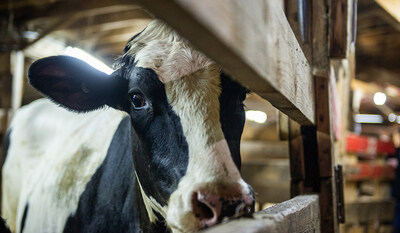Lack of inspections, economic support of sector and poor culling decisions have led to a culture of shipping cull dairy cows long distances to slaughter, when often unfit to be transported
TORONTO, Feb. 28, 2023 /CNW/ – World Animal Protection is calling on all stakeholders in the food system, including federal and provincial governments, the dairy industry and food businesses, to scale up regulatory inspections, strengthen enforcement, implement inter-jurisdictional cooperation and incorporate accountability regimes in supply chains to ensure cull dairy cows do not suffer en route to slaughter.
In Milking the Cow: The Fate of Canadian Cull Dairy Cows, World Animal Protection has uncovered a troubling pattern of sick or injured end-of-life (“cull”) dairy cows being sent to slaughter when they aren’t fit for transport.
Nearly one in four vehicles transporting cull dairy cows were found to have painful health conditions or injuries that compromise their welfare according to Canadian Food Inspection Agency (CFIA) reports, obtained by World Animal Protection.
“Farm animals deserve to be treated with dignity and must be protected by meaningful welfare standards, and it’s clear that the system is failing dairy cows,” said Lynn Kavanagh, World Animal Protection Farming Campaign Manager. “The inspection reports indicate an unacceptable pattern of neglect and lack of accountability which is in keeping with previous research on the subject.”
The reality is, for many cows, the journey to slaughter is long and arduous, by going first to auction, possibly thousands of kilometers away, only to be slaughtered hundreds to thousands of kilometers further still.
“The conditions experienced by these animals, as documented, paint an unacceptable picture of suffering for thousands of dairy cows,” said Dr. Jeff Rushen, Adjunct Professor at the University of British Columbia, who specializes in animal welfare and behaviour. “The dairy industry and CFIA must take action to ensure these animals receive better treatment and enforce the federal regulations.”
There are few plants in Canada that accept cull dairy cows, forcing farmers to send their animals hundreds to thousands of kilometres across the country, or into the United States. This represents a failure of government policy to ensure there are economic supports to sustain regional operations.
Research has found examples of cows from Newfoundland travelling to Ontario to be slaughtered, while cows from Quebec have been identified in British Columbia slaughterhouses. Freedom of Information (FOI) records obtained from the U.S. Department of Agriculture also show Canadian cows travelling as far as Texas to be slaughtered.
During transport, the quality of care is greatly reduced, despite regulatory requirements of having a minimum standard of care.
CFIA inspection reports from 2018 and 2019 show the rates of inspection are infrequent and enforcement is inconsistent. This has normalized a culture of non-compliance.
“The status quo has led to an unacceptable level of suffering for dairy cows as they approach end-of-life,” added Kavanagh.
Recommendations for meaningful change include:
- Alternatives to selling animals through auctions should be supported and promoted
- The dairy industry working with producers to promote ‘proactive culling’ and ensure ‘fitness for transport’ rules are met
- Minimum standards for enforcement be required at auctions and assembly yards
- Legislative and regulatory measures for auctions in all provinces must be implemented and include inspections and enforcement
- Regulatory and enforcement models should be harmonized, and inspections at all provincial auctions must be implemented
- Increased inspections and better enforcement of the Health of Animals Regulations are needed
Lynn Kavanagh, World Animal Protection’s Farming Campaign Manager, and investigators are available to speak to the report.
World Animal Protection has been leading efforts to bring systemic change to the animal agricultural sector for decades. Efforts include working with government and stakeholders to raise the bar for farm animal welfare, pushing the Canadian government to implement policies to phase-out inhumane farming practices, and working to change global financial investment systems that are fuelling factory farming expansion.
QUICK FACTS:
- There are almost 10,000 dairy farms in Canada with an average size herd of 96 cows per farm.
- Over 32% of dairy cows (about 198,000 cows) are removed (“culled”) from dairy herds each year in Canada.
- The multi-jurisdictional nature of regulations and laws governing farm animal welfare and the gaps in oversight present a challenge and contribute to the poor welfare often experienced by cull dairy cows.
SOURCE World Animal Protection



